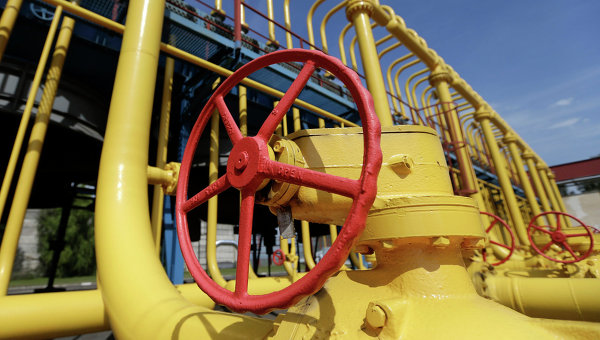
Ukraine Not Ready for Winter Without Russian Gas
Publication: Eurasia Daily Monitor Volume: 11 Issue: 171
By:

Russia has been threating those European states that have continued to deliver natural gas to Ukraine after Russia has cut its own supplies to the vulnerable Eastern European country. More recently, some progress has been made in the Russia-Ukraine gas talks being mediated by the European Union, but the sides are still far from reaching a final agreement. Meanwhile, little time remains until the middle of October, when Ukrainians normally have to start heating their homes. So Ukraine will likely need to brace itself for a frigid winter this year.
At the Berlin round of the Ukraine-Russia-EU gas talks on September 26, an interim agreement was reached to resume gas deliveries to Ukraine in October if Ukraine paid Russian Gazprom $3.1 billion by the end of this year. Gazprom is expected to deliver 5 billion cubic meters (bcm) of gas at $385 per 1,000 cubic meters of gas (Kommersant, September 27). This is down from the $485 Gazprom charged Ukraine as of April 1. Gazprom stopped deliveries to Ukraine on June 16 over a debt and pricing dispute. The Ukrainian government estimated recently that Ukraine would be short of 5 bcm of gas in the upcoming winter if Russia did not resume gas deliveries (lb.ua, September 26). Thus, it may seem that if the agreement reached on September 26 is confirmed by the two governments, Ukraine will have enough gas this upcoming winter.
However, the situation is more complicated. In fact, Andriy Kobolyev, the head of the Ukrainian national oil and gas company, Naftohaz Ukrainy, said on his Facebook page, summing up the September 26 agreement, that “no final decision was reached, no documents were signed, full stop” (facebook.com/andriy.kobolyev, September 26). Second, Ukraine may need more than the cited 5 bcm of gas. Gazprom CEO Aleksey Miller claimed that Ukraine was short of 7.5 bcm of gas to make it through the winter (1prime.ru, September 27), while EU Energy Commissioner Gunther Oettinger put the estimate at 5–12 bcm (publicist.in.ua, September 26). It is not clear whether Ukraine can count on more than 5 bcm of gas from Russia, according to the interim agreement.
Second, although Ukraine is ready to pay $3.1 billion, it is not clear what this is exactly for and when the sum will be transferred to Gazprom. The Russian Ministry of Energy said this payment would be part of a $5.3 billion debt owed by Ukraine (minenergo.gov.ru, September 26). However, the Ukrainian media cited Ukrainian Energy Minister Yury Prodan as saying that this money would be pre-payment for new deliveries, rather than debt payment (capital.ua, September 26). Also, Russia expects $2 billion by the end of October, while Ukraine is reportedly ready to pay up front only $1.5 billion (RIA Novosti, September 26).
Third, Ukraine continues to disagree with Russian prices and price formation mechanisms, saying that Russia’s prices for the EU are lower. Prodan insisted that Russia should eventually cut its price per 1,000 cubic meters of gas back to the $268.50 Ukraine paid in the first quarter of 2014, according to agreements reached by the previous government with Moscow last December. Kyiv also disagrees with Moscow regarding regulating its price for Ukraine through removing or introducing export duties so the price can be changed any time, at will (RIA Novosti, September 26). Moreover, Kyiv claims that Gazprom itself owes $6 billion to Ukraine because Naftohaz overpaid in previous years (publicist.in.ua, September 26).
Kyiv’s hopes to live through the winter without Russian gas were dashed earlier this month when it became clear that Gazprom would not stop short of blackmailing the EU over reverse gas flows. Ukraine resumed importing gas from Poland and Hungary last spring and began pumping gas also from Slovakia in September in an effort to offset the cut in Russian gas supplies. However, Poland, Slovakia, as well as Austria recently started complaining that Russia decreased gas deliveries to them (Moscow Echo, September 24). On September 25, Hungary stopped gas deliveries to Ukraine for an indefinite period, citing increased domestic demand. Naftohaz noted that this happened after a meeting between President Vladimir Putin and Hungarian Prime Minister Viktor Orban (fgsz.hu, naftogaz.com, September 25). Eventually, Russian Energy Minister Aleksandr Novak made it clear that gas deliveries to Europe would be stable only if the EU stopped “re-exporting” gas to Ukraine (minenergo.gov.ru, September 26).
Ukrainian domestic gas production of around 20 bcm per annum is not enough to meet overall domestic demand of around 45–50 bcm of gas. By September 25, Ukraine stored only 16.6 bcm of gas in its underground storage facilities (Pravda.com.ua, September 26). And recent events have shown that the EU cannot be fully relied upon as an alternative gas supplier. Furthermore, the possibility of replacing natural gas with other fuels is limited. Most of Ukraine’s co-generation plants, which supply large cities with heating and hot water, are designed to burn gas only (zn.ua, September 26). And those thermal power plants and co-generation plants that use coal are short of it because, due to the war with Russia-backed militants in Ukraine’s main coal region of Donbas, national coal production has been halved in August alone (ukrstat.gov.ua, accessed on September 27). Ukraine, earlier this year, brought a case before the arbitration court in Stockholm over Gazprom’s prices, but a verdict is expected only next year (censor.net.ua, September 24). Thus, it is increasingly likely that Ukraine may be forced to make concessions to Russia at the next round of gas talks expected on October 1–22 (zn.ua, September 27).




